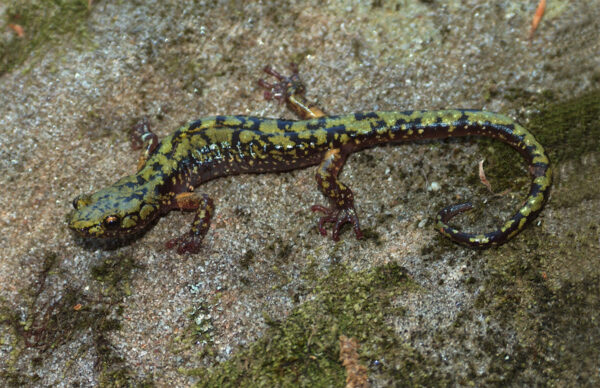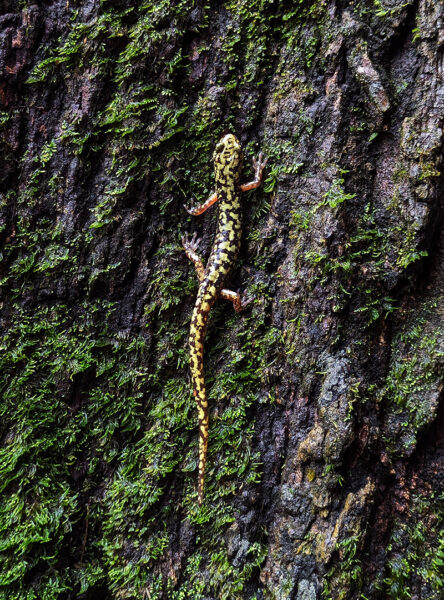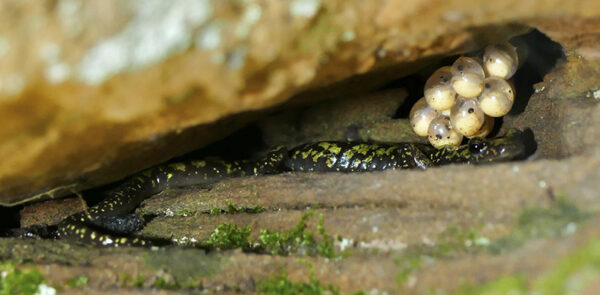An up-close look at a Green Salamander. Photo by ©Scott Bolick
A Green Salamander resting within his rock crevice. Photo by ©Aaron Mazuelos
Fact File
Scientific Name: Aneides aeneus
Classification: Amphibia, Order Caudata, Family Plethodontidae
Conservation Status:
- Species of Greatest Conservation Need-Tier 2b on the Virginia Wildlife Action Plan
Size: Averages about 3 to 5.5 inches in length
Life Span: 13+ years
Distribution
The Green Salamander in Virginia is restricted to the Cumberland Mountain and Northern Ridge and Valley ecoregions of southwest Virginia.

Identifying Characteristics

A photogenic Green Salamander. Photo by ©Mike Graziano
- Head and body are vertically compressed
- Head is broad; typically wider than the body
- Skin is mottled with green-yellow splotches that visually resemble lichen
- Relatively long legs with splayed feet and square toes
- Feet are slightly webbed
Habitat

A Green Salamander camouflaged among the moss in a rock crevice. Photo by ©Aaron Mazuelos
The Green Salamander thrives in areas that remain shaded, cool, and humid. While the species is most closely associated with moist crevices in rocky outcrops of forested areas, new research shows they may use trees more than rocky habitat during summer months, and juveniles use trees more than adults. Torpor occurs in the same outcrops, usually between December and March.

A Green Salamander climbing up mossy tree bark. Photo by ©Myles Masterson
Diet
Green Salamanders, like many other amphibians, are opportunistic feeders. Primary food items typically include small invertebrates, snails, and slugs.

Green Salamanders will forage amongst leaves and moss for easy prey items. Photo by ©Dane Conley
Reproduction

A Green Salamander breeding pair and their eggs. Photo by ©Wally Smith
Green Salamanders are terrestrial breeders, seeking out rock formations to carry out their reproductive strategy. Breeding in Virginia occurs in May and June. The female Green Salamander uses mucus to attach egg clusters to the ceiling of a rock crevice, and will often remain in the area. Hatchlings typically emerge from eggs in 3 to 5 weeks.
Last updated: August 10, 2025
The Virginia Department of Wildlife Resources Species Profile Database serves as a repository of information for Virginia’s fish and wildlife species. The database is managed and curated by the Wildlife Information and Environmental Services (WIES) program. Species profile data, distribution information, and photography is generated by the Virginia Department of Wildlife Resources, State and Federal agencies, Collection Permittees, and other trusted partners. This product is not suitable for legal, engineering, or surveying use. The Virginia Department of Wildlife Resources does not accept responsibility for any missing data, inaccuracies, or other errors which may exist. In accordance with the terms of service for this product, you agree to this disclaimer.

